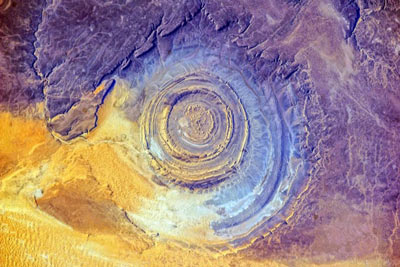
It was always there, yet for millions of year the eye of the Sahara was unseen in plain sight. It was unnoticed, since this huge and mysterious geologic formation is hard to spot from the ground level in the otherwise featureless expanse of the desert. This incredible bull’s-eye in the sand is actually discovered from some pictures of the Earth’s terrain, taken by the astronauts. The stunning structure of the Eye of Sahara, the bare rock peeping out from a vast sea of sand, formed a beautiful landmark for the astronauts.
The Eye of Sahara, also known as the Richat Structure or Guelb er Richat, is a giant geological wonder of the world. It is a deeply eroded, slightly elliptical, massive dome with a diameter of 40 kilometres circular structure in the heart of the Sahara Desert of Mauritania, near Ouadane.

Initially, the Eye of Sahara was considered as an asteroid impact structure because of its high degree of circularity. But, no credible evidence has been found indicating any hypervelocity extraterrestrial impact in the area. It also lacks the annular depression that denotes large extraterrestrial impact structures of this size. For a while, scientists also thought that it was an impact of a volcanic eruption. But, that also seems improbable as they did not find enough melted rock.
Today, the Eye of Sahara is considered to be a highly symmetrical and deeply eroded geologic dome, which finally collapsed. It was probably caused by the uplifted rock sculpted by erosion, creating a dome of rock layers, like a very large pimple. This also resulted the fault lines circling the Eye and crossing it. The limestone near the center of the eye was also ultimately dissolved by the molten rocks and collapsed to form a special type of rock, called ‘Breccia’. However, that is also a theory, the Eye of the Sahara is still an enigma for the scientists.

The northwest side of the Eye is with ‘Kediet ej Jill Mountain’. The mountain has a large concentration of magnetite, which may be responsible for the bluish tinge of the Eye. The entire plateau of sedimentary rocks is 200 metres above the desert, and 485 metres above the sea level. Prevailing winds from the northeast funnel around the bedrock cliffs swept the sand, exposing a sand-barren streak downwind.

It is interesting to note that, some people believe the Eye of the Sahara is actually the remains of the lost city of Atlantis, as described by Plato.